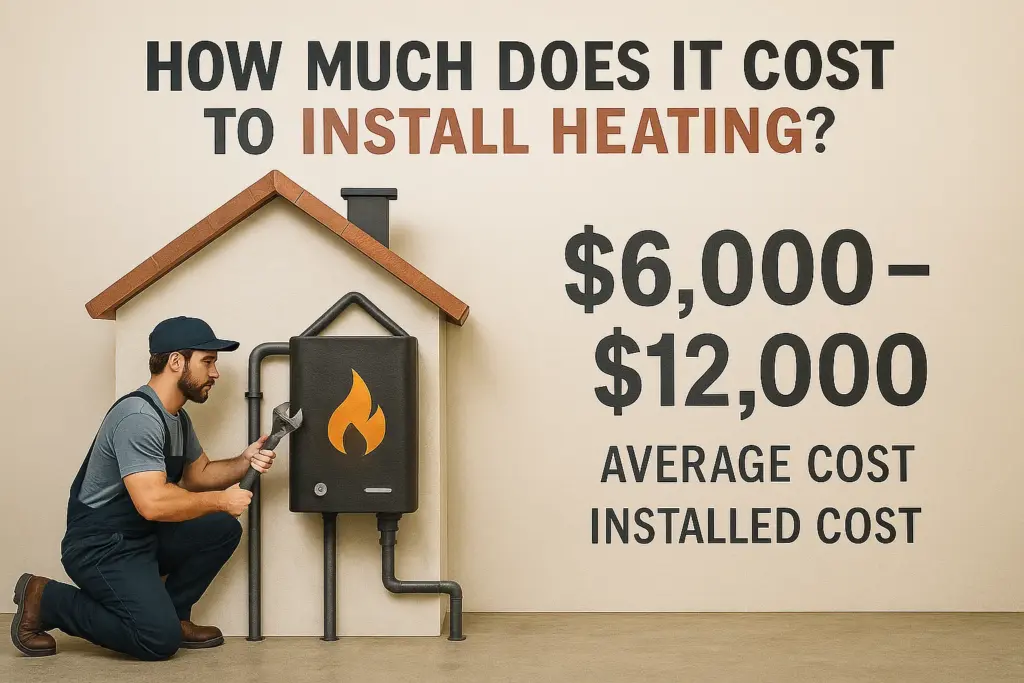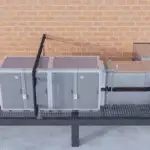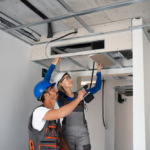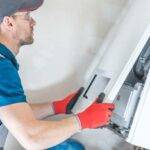Installing a heating system is a big deal for your home. Knowing the costs is key to making smart choices. At High Comfort, we aim to give you clear and confident options, ensuring you get the most value.
So, what affects the heating installation cost estimate? Is it the heating system type, your home’s size, or something else? Many factors play a role, like the installation’s complexity and the heating system installation pricing.
When looking at your options, think about more than just the initial cost. Consider the long-term benefits and savings too. This way, you can choose what fits your budget and comfort needs best.
Key Takeaways
- Understanding the factors that influence heating installation costs is key for budgeting.
- The type and size of the heating system greatly affect the cost.
- Installation complexity can also impact the total cost.
- Think about long-term benefits and savings.
- Comparing different heating systems helps you make a better choice.
Understanding Different Heating Systems and Their Installation Costs
Choosing the right heating system is important. You need to know the costs of different types. Each system has its own benefits and drawbacks, affecting your initial cost and future energy bills.
Forced Air Heating Systems
Forced air heating systems are very common, mainly in cold areas. They circulate warm air through ducts and vents. The average cost to install a heating unit varies based on several heating installation cost factors, like efficiency and installation complexity.
Gas Furnaces vs. Electric Furnaces
Gas furnaces are often chosen for their efficiency and cost savings, if natural gas is available. “Gas furnaces can save a lot on energy bills compared to electric furnaces,” experts say. But, electric furnaces are simpler to install and maintain, great for small spaces or areas without natural gas.
Radiant Heating Options
Radiant heating systems warm up directly, using hydronic or electric systems to heat floors or walls. They work well in well-insulated homes.
Hydronic vs. Electric Radiant Systems
Hydronic radiant systems use heated water in pipes under the floor for consistent warmth. Electric radiant systems use electric mats or cables. Hydronic systems are more cost-effective over time, but electric systems are easier and less expensive to install.
Heat Pump Systems
Heat pump systems provide both heating and cooling by transferring heat. The cost depends on the type of heat pump and installation complexity.
Air-Source vs. Geothermal Heat Pumps
Air-source heat pumps are more common and less expensive than geothermal heat pumps, which need underground ductwork. But, geothermal systems are more efficient and can cut energy bills significantly. A leading HVAC expert notes, “Geothermal heat pumps can be up to four times more efficient than traditional systems.”
It’s key to understand the different heating systems and their costs to make a smart choice. By looking at heating installation cost factors and the average cost to install a heating unit, you can find a system that offers good value for your money.
Factors That Affect How Much It Costs to Install Heating
When you think about installing a heating system, several important factors come into play. These factors can greatly affect the cost. It’s key for homeowners to understand these elements to make smart choices and find the best deal.
Home Size and Layout Considerations
The size and layout of your home are key in choosing the right heating system. Bigger homes need more powerful systems, which can raise costs. Also, complex layouts might need more work, adding to labor costs.
To find the cheapest way to install heating, pick a system that fits your home well. A well-insulated home might need a less powerful system, saving money. The layout of your home, including the number of stories and windows, also affects heating needs.
Existing Infrastructure and Necessary Modifications
The current setup in your home, like ductwork or radiators, affects installation costs. If your home already has what you need, costs will be lower. But, if big changes are needed, costs will go up.
For example, adding new ductwork is expensive but needed for some systems. Homes without ductwork might find other systems like radiant floor heating or heat pumps cheaper, despite their own challenges.
Regional Climate Requirements Across the US
The climate in your area greatly influences the heating system you need. Colder areas need stronger systems, which cost more. Knowing your climate is key to picking the right system and understanding heating installation cost factors.
In colder places like the Northeast or Midwest, you’ll need more powerful systems than in warmer areas like the South. This affects both the initial cost and ongoing expenses.
Energy Efficiency Ratings and Long-term Costs
The energy efficiency of a heating system is very important. More efficient systems cost more upfront but save money over time.
Look at the Annual Fuel Utilization Efficiency (AFUE) for furnaces and boilers, or the Seasonal Energy Efficiency Ratio (SEER) for heat pumps. Higher ratings mean better efficiency, leading to lower bills and possible rebates or tax credits.
Labor Costs and Geographic Variations
Labor costs vary by location, affecting heating installation costs. Urban areas usually have higher labor costs than rural areas, impacting the total cost.
To save on labor costs, get quotes from different contractors and compare services. Also, installing during off-peak seasons can help get better rates.
Average Heating Installation Costs by System Type
The cost to install a heating system varies a lot, depending on the type you pick. Each system has its own needs and prices. Knowing these differences helps you choose wisely, fitting your budget and needs.
Furnace Installation Costs
Furnace prices change based on the type and how efficient it is. Standard efficiency furnaces cost less at first but might cost more over time because of higher bills.
Standard vs. High-Efficiency Furnaces
High-efficiency furnaces cost more to start but save money in the long run. Think about both the cost to install and the savings when choosing between standard and high-efficiency furnaces.
Boiler System Installation Pricing
Boiler systems are a common choice, with prices based on the boiler type and efficiency. Condensing boilers are more efficient but might cost more upfront.
Standard vs. Condensing Boilers
When comparing standard and condensing boilers, consider the initial cost and long-term savings. Condensing boilers can save a lot of money over time, making them a good choice for many.
Heat Pump Installation Expenses
Heat pumps are energy-efficient, with costs changing based on the system type and size. Ductless mini-split systems are popular for their flexibility and efficiency.
Ductless Mini-Split Systems
Ductless mini-split heat pumps are easy to install and save energy. They’re a cost-effective option, great for mild climates.
Radiant Floor Heating Costs
Radiant floor heating systems provide even heat but cost more to install. The area size and flooring type affect the total cost.
| Heating System Type | Average Installation Cost | Efficiency Rating |
| Furnace (Standard) | $2,000 – $4,000 | 80-90% |
| Furnace (High-Efficiency) | $3,000 – $6,000 | 90-98% |
| Boiler (Standard) | $3,500 – $6,500 | 80-85% |
| Boiler (Condensing) | $4,500 – $8,000 | 90-95% |
| Heat Pump | $2,500 – $5,000 | 15-20 SEER |
| Radiant Floor Heating | $8,000 – $15,000 | Varies |
Knowing the average costs for different heating systems helps you make a smart choice. Think about both the initial cost and long-term savings when picking a heating system.
DIY vs. Professional Heating Installation: Cost Comparison
Installing a heating system can be tough. You must decide if you should do it yourself or hire a pro. This choice affects your money and safety. It depends on your skills, the job’s complexity, and your budget.
When DIY Installation Is Possible
DIY can save money for simple systems or if you know HVAC. But, be honest about your skills and the risks.
- Simple heating system replacements or upgrades
- Homeowners with prior HVAC experience
- Projects that don’t require extensive electrical or plumbing work
If the job is complex or you’re unsure, get professional help.
Professional Installation Benefits and Costs
Professional installation has many perks. It includes warranty, code compliance, and safety assurance.
Benefits of Professional Installation:
- Warranty coverage for parts and labor
- Compliance with local building codes and regulations
- Expertise in handling complex installations
- Safety assurance
The cost of professional installation varies. It depends on location, system complexity, and contractor rates. On average, it’s $500 to $2,000 more than DIY.
| Installation Type | Average Cost | Factors Affecting Cost |
| DIY Installation | $500 – $1,500 | System complexity, materials needed |
| Professional Installation | $1,500 – $3,500 | Labor costs, contractor rates, system complexity |
Hidden Costs and Possible Pitfalls
Both DIY and professional installations have hidden costs. DIY might have unexpected repair costs or tool expenses. Professional installations might have upselling or extra fees for permits.
Safety Considerations and Permit Requirements
Safety is key when installing a heating system. Make sure you follow local rules and get the right permits. Professionals know these rules and can help you.
Finding and Vetting Qualified HVAC Contractors
Choosing a professional installer is important. Look for licensed, well-reviewed contractors. Get quotes to compare prices and services.
- Check for licenses and certifications
- Read reviews and ask for referrals
- Get multiple quotes
- Verify insurance and warranty coverage
By understanding the costs and options, you can make a smart choice that fits your needs and budget.
Ways to Save Money on Heating Installation
There are many ways to cut down on the cost of heating installation. Getting a new heating system is a big deal. It’s important to find ways to save money without sacrificing quality.
Timing Your Installation for Maximum Savings
Installing your heating system during the off-peak season can save you money. HVAC companies give discounts when it’s slow, usually in spring or fall. This way, you get a better price and a less busy installation time.
Available Tax Credits and Rebates in the US
The US government has tax credits and rebates for energy-saving heating systems. These can lower the cost of your new heating system. For example, installing an energy-efficient heat pump might get you a federal tax credit. Make sure to check what’s available in your area.
Financing Options and Payment Plans
Many HVAC companies offer financing and payment plans. This helps spread out the cost of installation. When looking at financing, compare different offers to find the best one for you.
Energy-Efficient Choices That Pay Off Long-Term
Energy-efficient systems might cost more upfront, but they save money on bills over time. A high-efficiency furnace or heat pump can cut down on energy use. Think about the long-term savings when choosing a heating system.
Bundling Multiple HVAC Services
Getting your heating installation, maintenance, and repair from one company can save you money. Many offer package deals or loyalty programs. Talk to your HVAC contractor about bundling options.
Using these strategies can make your heating installation more affordable. Always compare options and ask your HVAC expert for advice. This way, you can get a good deal without overspending.
Conclusion
Figuring out the cost to install heating in your home is complex. It depends on the heating system type, labor costs, and energy efficiency. By making smart choices and using cost-saving tips, you can get a cozy and efficient heating system.
When looking at heating system installation costs, think about the average price for a heating unit. Consider your home’s size, current setup, and the local climate.
At High Comfort, we aim to redefine comfort for you. This guide has helped you understand heating installation better. Now, you can make choices that fit your needs.
FAQ
How much does it typically cost to install a heating system in a home?
The cost to install a heating system in a home varies a lot. It depends on the system type, home size, and labor costs in your area. On average, expect to pay between $3,000 to $10,000 or more for a full installation.
What factors affect the cost of heating installation?
Several things affect heating installation costs. These include home size and layout, existing setup, climate needs, energy efficiency, and labor costs. Knowing these can help you estimate the total cost.
Are there any cost-saving strategies for heating installation?
Yes, there are ways to save on heating installation. Installing during off-peak seasons, using tax credits and rebates, and picking energy-efficient systems can lower costs. Also, getting multiple services at once and using financing options can save money.
Should I choose DIY or professional heating installation?
DIY can be cheaper for simple tasks. But, professional installation is needed for complex systems. It ensures a safe and correct setup. A qualified HVAC contractor can guide you through the process.
How do I find a qualified HVAC contractor for my heating installation?
To find a good HVAC contractor, look up local pros, read online reviews, and ask for referrals. Make sure they are licensed, certified, and insured. Get quotes from several to compare prices and services.
What are the average costs for different types of heating systems?
Costs for heating systems vary by type. Furnace installation costs range from $1,000 to $6,000. Boiler systems cost between $3,000 to $10,000. Heat pumps cost from $2,000 to $8,000. Radiant floor heating can cost $6,000 to $15,000 or more.
How do energy efficiency ratings impact heating installation costs?
Energy efficiency ratings greatly affect costs. Higher-efficiency systems cost more upfront but save money on bills over time. Look at the SEER rating for heat pumps and the AFUE rating for furnaces when choosing.




